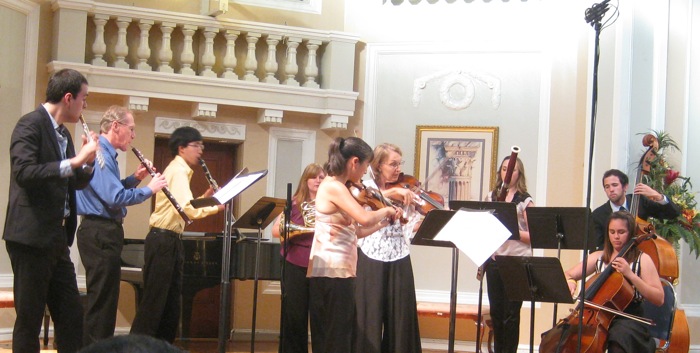New festival springs up in the South Bay
“A small idea runs through the works,” explained musicologist Danielle Sofer before the final concert of San Jose’s newest chamber music festival. Moving from podium to piano, she illustrated with motifs that developed simply and stepwise. And thus began a not-so-simple venture.
Founded by a young and sophisticated duo, the Silicon Valley Music Festival just finished its 2012 inaugural season with a week of concerts in downtown San Jose. Flutist Ray Furuta and pianist Jasmin Arakawa are the Co-artistic Directors, and also concertize around the world as the Furuta-Arakawa Duo. Another flutist, Jodie Rottle, is Executive Director, bringing a woodwind emphasis to this new South Bay chamber festival. Capitalizing on artists met at the Banff Center and other summer festivals, the three have put together an impressive series of eight concerts, three of them free.
Contemporary and older works were arrayed against the Romanticism of Robert Schumann, performed by an adventurous mix of distinguished and entering artists.
The finale, Friday June 29, was held in San Jose’s Le Petit Trianon Theatre, a fine space for chamber groups. That modest, high-ceilinged space, around 30 feet wide and 25 feet high, is intimate by theater standards, but the hard surfaces and flat glassed-in roof were so lively that speakers needed no amplification—perfect for piano and string quartets, and adding a reverberant luster to winds. But if you sat too close to a wall, spoken words developed “gymnasium” muddle!
Nine performers took the stage, a string quartet combined with a woodwind quintet, for Louis Spohr’s Grand Nonetto. It was a suave early nineteenth century experiment, with the “small ideas” mentioned in the introduction combined with deft hand-offs.
Violinist Salley Koo showed a brittle beauty with clean runs and sharply etched high notes, while oboist Mark Hill anchored the winds. Furuta and clarinetist Katsuya Yuasa played tag with oboe, while bassoonist Shelley Monroe Huang added an opulent agility.
In the third movement the four strings dug into alluvial richness, and suddenly we were exploring a regret that Schumann could have mined. But Spohr bounced back in the fourth, running up the scales and sliding down the banisters.
Next, Furuta and pianist Arakawa were joined by flutist Elena Yarritu for Au-Dela du Temps (Transcending Time), written in 2002 by Yuko Uebayashi. Born in 1975 in Japan and schooled in Paris, Uebayashi seasons the impressionism of Ravel and Debussy with Eastern spices. And then propels it with an inward passion.
Her inspiration is Paris, and her notes describe each movement as light: the first movement is “Night and Distant Light,” then “Dancing Light.” The slower third movement, “white light,” describes the revealing half-light of dawn, and the fourth movement is titled “in a dream, revolving light.”
That “light” is translated into the burnished voices of two flutes, over a piano accompaniment that resisted pedaling for a texture that was woody in the mid-range and plinky at the top, but seldom rumbled: a gentle ground for the expression of the higher voices.
After the deceptively simple motifs of the opening, the adventurous second movement, and sumptuous harmonies and pianistic birdcalls of the Zen-like third movement, the finale was surprisingly up beat. I wondered if this was part of a French conspiracy to finish all sorrows with a smile.
At intermission I congratulated flutist Elena Yarritu, who then spoke of the fluid and challenging key changes, and showed me her score. It was dense with accidentals, and considerably higher than I remembered, even though she often took the lower system. Her unisons and harmonies with Ray Furuta were so pure that I was unsurprised to learn that he was her former pupil. That special bond made for some magic moments.
After intermission, we finally got to hear the Schumann. His Piano Quartet in E-Flat was everything one hoped for: passion and promise, vision and grief.
Violinist Helen Kim, violist Katherine Murdock and cellist Agnes Kallay gave the slow opening a hair-raising blend, and pianist Jingwen Tu added notes like pebbles, solid and worn round with care. The fast scherzo was satisfyingly taut, and in the slow cantabile movement cellist Kallay propelled the work with resonances that stretched the gamut of human hearing. One of the most performed of all piano quartets, Schumann’s masterpiece remains an astonishing blend of craftsmanship and passionate nature, based on “small ideas” taken to extreme. This was a very tight reading.
This festival will return next year, along with winter master classes and the debut of their chamber music institute for students. Their future plans sound very exciting! More information will be available at www.svmusicfestival.org.
—Adam Broner
Photo of musicians performing Nonetto, from left: Ray Furuta, Mark Hill, Katsuya Yuasa, Amanda Tabor (obscured), Salley Koo, Katherine Murdock, Shelley Monroe Huang, Scott Padden and Stephanie Flores; photo by Christiane Khan.

